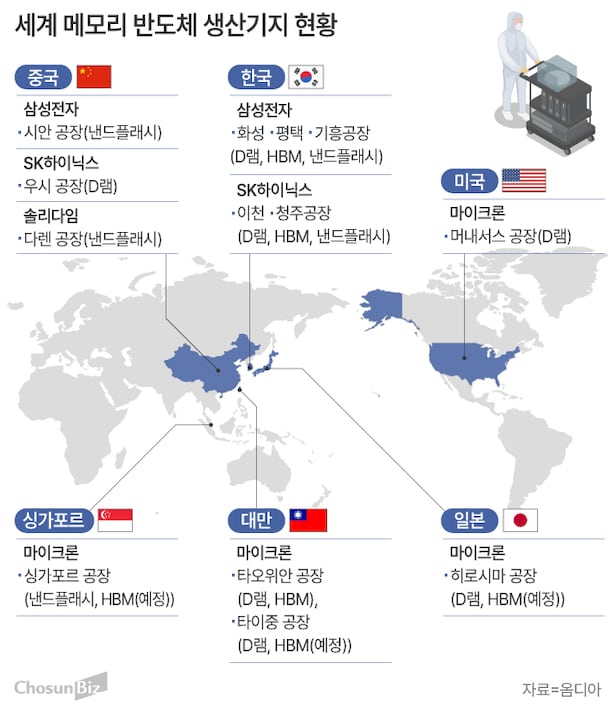
As the semiconductor tariff initiated by Donald Trump is expected to soon take shape, the profitability calculations of the three major companies in the memory semiconductor industry—Samsung Electronics, SK hynix, and Micron—are active. The United States imports over 90% of its memory semiconductors. While Micron has a plant in Manassas, Virginia, the equipment is outdated, and production volume is low, leading to a situation where it relies 100% on imports for advanced memory.
The semiconductor industry anticipates that it will be difficult for President Donald Trump to impose heavy tariffs on semiconductors. However, even if general tariffs are applied without specific measures regarding semiconductors, Micron is expected to hold a relative advantage among the three major memory semiconductor companies. This is because Samsung Electronics and SK hynix have their production facilities concentrated in Korea and China, while Micron has its operations dispersed in Singapore, Taiwan, Japan, and the United States.
According to an analysis of global semiconductor production conducted by market research firm Omdia, which was obtained by ChosunBiz on the 14th, it is expected that SK hynix will suffer the most from the semiconductor tariffs among Samsung Electronics, SK hynix, and Micron. Even if general tariffs or exemption measures are applied to memory semiconductors, the high level of tariffs targeting China by the Trump administration could pose risks, particularly for SK hynix, which produces about 40% of its annual DRAM output in China.
In the case of Micron, its production facilities are located in Taiwan, Singapore, Japan, and other regions. The oldest facility, Fab 4 (Manassas), is situated in the United States, but it has outdated equipment and is mass-producing legacy DRAM, contributing only 8% (80,000 wafers) of its total production (900,000 wafers).
Micron's main production base, the Singapore plant, has one of the lowest mutual tariff rates with the United States. The remaining production is shared approximately equally between the Taoyuan plant in Taiwan (Fab 11), the Taichung plant (Fab 16), and the Hiroshima plant in Japan (Fab 15), each contributing about 30% to DRAM production. The contribution of locally produced NAND flash at Micron is about 20% of the total. However, from this year, Micron plans to modernize its aging fabs located in the United States, investing to produce advanced products like high-bandwidth memory (HBM) in the mid-to-long term.
Samsung Electronics produces most of its DRAM at factories in Hwaseong and Pyeongtaek, Korea. If general tariff measures are applied to memory semiconductors, only a basic tariff of about 10% is likely to be imposed. However, the Xi'an plant in China is a concern. Samsung Electronics' largest NAND flash production base, the Xi'an plant accounts for over 40% of its total NAND flash output. As of last year, the wafer production volume at the Xi'an plant was about 570,000, representing 44% of the total (1.27 million). Even if a general tariff is applied, the risks associated with China are considerable.
The most disadvantaged company is SK hynix. According to Omdia data, SK hynix produced 2.1 million DRAM wafers in its plant in Wuxi, China, last year, which accounted for 41% of its total production of 5.11 million wafers. The tariff risk on DRAM, which has a high operating profit margin, is the highest among the three companies.
A semiconductor industry official noted, "Both DRAM and NAND flash have a structure where the majority of volume is imported from abroad, making it difficult to throw the tariff bomb that could cause IT inflation." He explained, "However, even if general tariffs are applied, SK hynix, which has a high dependence on China, is expected to suffer the most damage."
Meanwhile, according to foreign media outlets like Reuters and AFP on the 13th (local time), President Trump stated, "We did that with steel, automotive, and aluminum. (The tariffs on steel and automotive) are currently fully implemented," and added, "We will do the same with semiconductors." He mentioned that the "semiconductor tariff will be implemented in the near future."